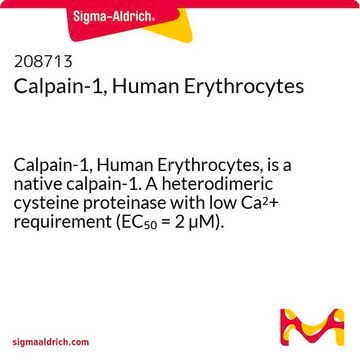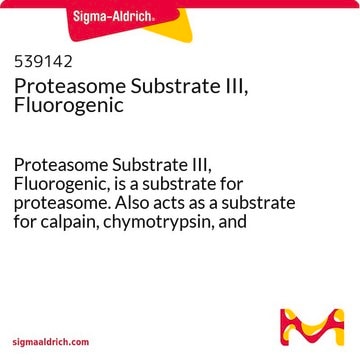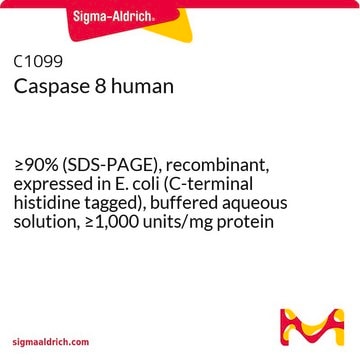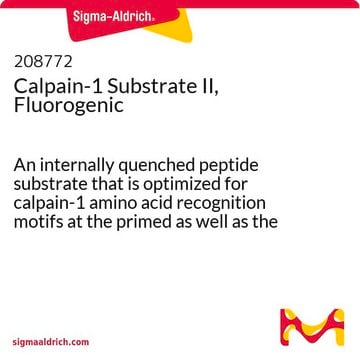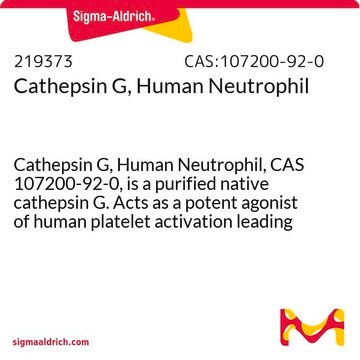208712
Calpain-1, Porcine Erythrocytes
Calpain-1, Porcine Erythrocytes, is a native calpain-1. A heterodimeric cysteine proteinase with low Ca2+ requirement (EC₅₀ = 2 µM).
Sinónimos:
μ-Calpain
About This Item
Productos recomendados
Nivel de calidad
Formulario
liquid
actividad específica
≥1000 units/mg protein
fabricante / nombre comercial
Calbiochem®
condiciones de almacenamiento
OK to freeze
avoid repeated freeze/thaw cycles
pI
5.3
Condiciones de envío
wet ice
temp. de almacenamiento
−70°C
Categorías relacionadas
Descripción general
Calpains are heterodimers of 80 kDa and 30 kDa subunits. The 80 kDa unit has the catalytic site and is unique to each isozyme. The 30 kDa unit is a regulatory subunit and common to both calpain I and calpain II. The 80 kDa unit consists of four domains (I-IV). The 30 kDa unit has two domains (V and VI).
• Domain I is partially removed during autolysis.
• Domain II is the protease domain.
• Domain III exhibits a homology with typical calmodulin binding proteins and interacts with calcium binding domains (IV and VI) and frees domain II for protease activity.
• Domain IV is a calcium binding domain.
• Domain V contains a hydrophobic region and is essential for calpain interaction with membranes.
• Domain VI is a calcium binding domain.
More recently, attention has been focused on the pathological significance of calcium accumulation in the central nervous system following cerebral ischemia and traumatic brain injury. Over-activation of NMDA, kainate, and AMPA receptors in the brain leads to sustained influx in Ca2+ through voltage gated Ca2+ channels. Disturbances in calcium homeostasis result in the activation of several calcium-dependent enzymes including calpains. Over-expression of calpains has been positively linked to both acute and chronic neurodegenerative processes including ischemia, trauma, and Alzheimer′s disease. In Alzheimer′s disease the ratio of active (76 kDa) to inactive (80 kDa) calpain I is reported to be much higher. Calpain proteolysis is usually the late-stage common pathway towards cell death induced by excitotoxic compounds.
Envase
Advertencia
Definición de unidad
Forma física
Reconstitución
Otras notas
Sorimachi, H., et al. 1997. Biochem. J.328, 721.
Kampfl, A., et al. 1997. J. Neurotrauma14, 121.
Johnson, G.V.W., and Gutmann, R.P. 1997. BioEssays19, 1011.
Bartus, R.T., et al. 1995. Neurol. Res.17, 249.
Wang, K.K.W., and Yuen, P.-W. 1994. Trends Pharmacol. Sci. 15, 412.
Saito, K., et al. 1993. Proc. Natl. Acad. Sci. USA90, 2628.
Goll, D.E., et al. 1992. BioEssays14, 549.
Ishii, H., et al. 1992. Biochim. Biophys. Acta1175, 37.
Melloni, E., and Pontremoli, S. 1989. Trends Neurosci.12, 438.
Ross, E., and Schatz, G. 1973. Anal. Biochem.54, 304.
Información legal
Código de clase de almacenamiento
10 - Combustible liquids
Clase de riesgo para el agua (WGK)
WGK 2
Certificados de análisis (COA)
Busque Certificados de análisis (COA) introduciendo el número de lote del producto. Los números de lote se encuentran en la etiqueta del producto después de las palabras «Lot» o «Batch»
¿Ya tiene este producto?
Encuentre la documentación para los productos que ha comprado recientemente en la Biblioteca de documentos.
Active Filters
Nuestro equipo de científicos tiene experiencia en todas las áreas de investigación: Ciencias de la vida, Ciencia de los materiales, Síntesis química, Cromatografía, Analítica y muchas otras.
Póngase en contacto con el Servicio técnico